QUEBEC CITY — The last time a Canadian World Cup race was held east of Thunder Bay, Gunde Svan (SWE) stood atop the podium, and Pierre Harvey (CAN) placed 4th.
Twenty-seven years later, the big show of ski racing has returned to the Atlantic coast of Canada and local star Alex Harvey, son of Pierre, will battle for the top-3.
Compared to the 15km classic race held in 1985, the weekend of racing kicking off Friday in Quebec City couldn’t be more different. The technique will be skating, and the formats are relatively new-fangled team sprint and sprint.
It is hard to believe Svan, Harvey or any of the other contestants in Labrador City in ’85 imagined a race held in the front yard of the Quebec Parliament building during active session, on a narrow twisting course, complete with steep bridges, head-to-head competition and a small “jump.”
With the 126-year-old Parliament looming above, and the copper roof of the famed Château Frontenac glistening in the afternoon sun, the world’s best cross-country skiers sped around an 860-meter ribbon of snow, testing lines through corners and scouting the best opportunities for passing.
“This is how ski racing is meant to be,” a smiling Erik Flora, head coach of Alaska Pacific University Nordic Ski Club (APUNSC), said as he made his way from the course to the waxing compound.
Flora, on-site to prepare skis for APU athletes selected to race as part of the nation’s group quota, pointed to the challenging, yet navigable corners and the flow as highlights of the course.
But after skiing roughly 100 laps while testing skis, the main attraction is the need to “be good at everything.”
Skiers must to be able to handle just about every type of terrain and course feature to succeed, according to Flora.
And the “jump,” actually an abrupt drop of 30-centimeters, something that has never appeared in a World Cup course?
“I favor it,” Flora said a sentiment echoed by American skiers Andy Newell and Sylvan Ellefson.
Newell, famed for his ability on skis, including a penchant for big air, sees such additions as a personal advantage while Ellefson thinks anything that makes the sport more exciting to watch is positive.
Finnish head coach Magnar Dalen feels differently, envisioning broken skis, crashes and the fact that the drop, and ensuing jolt, is not ideal for skiers with bad backs.
The brainchild of Patrice Drouin, President of Gestev, the firm organizing the event, the feature will appear in both Friday’s team sprint and Saturday’s individual event.
Like most city sprints, passing space is at a premium, but there is room to move. After each sweeping turn, the course opens up, albeit briefly, and Flora sees these stretches as the critical spots.
Skiers will race two laps, and in the team sprint, will alternate with a single teammate for a total of three legs each.
With limited width, Newell cautions that it isn’t good enough to be looking to advance through the field.
“You need to make sure you aren’t getting passed. No one is going to want to be at the back,” he explained, and predicted a constant fight for position.
The longest straight stretch is also the run to the finish, a gradual uphill that should provide plenty of drama at the end of each heat.
Success in such events does not necessarily come to the fastest or the fittest — sometimes it is the luckiest who takes the top prize. Staying out of trouble is not just important, it is essential for a shot at the podium.
American Kikkan Randall, who staged a dramatic comeback in both the Dusseldorf and Milan city sprints last year, will be racing her first skate sprint of the season.
Flora, her coach, sees the course as playing to the defending Sprint Cup Champion’s strengths.
“Kikkan is good in packs and on turns,” Flora said. He also pointed to her impressive power, necessary for accelerating out of the corners.
And the ledge will not faze her. After trying just about every technique possible to clear the small drop, Flora concluded that aggressiveness is the best approach, and he is confident that Randall will not hesitate.
After skiing with her during the morning training session, Flora sees the potential for big results from Randall over the next two days
“I usually know it’s a good sign if I can barely keep up, and I can barely keep up,” he said.
A total of 16 North American teams take to the track on Friday — four each of men and women from Canada and the US.
Sylvan Ellefson (USA) previewed the course on a cold, but sunny day.
Quebec World Cup from Sylvan Ellefson on Vimeo.



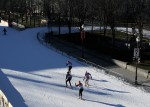
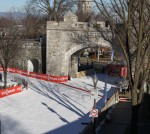
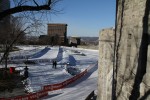



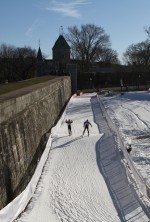
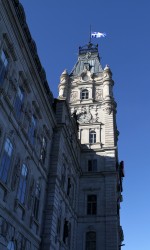



One comment
Pingback: Racing with the Big Dogs–Quebec City World Cup Sprints | Lauren Fritz